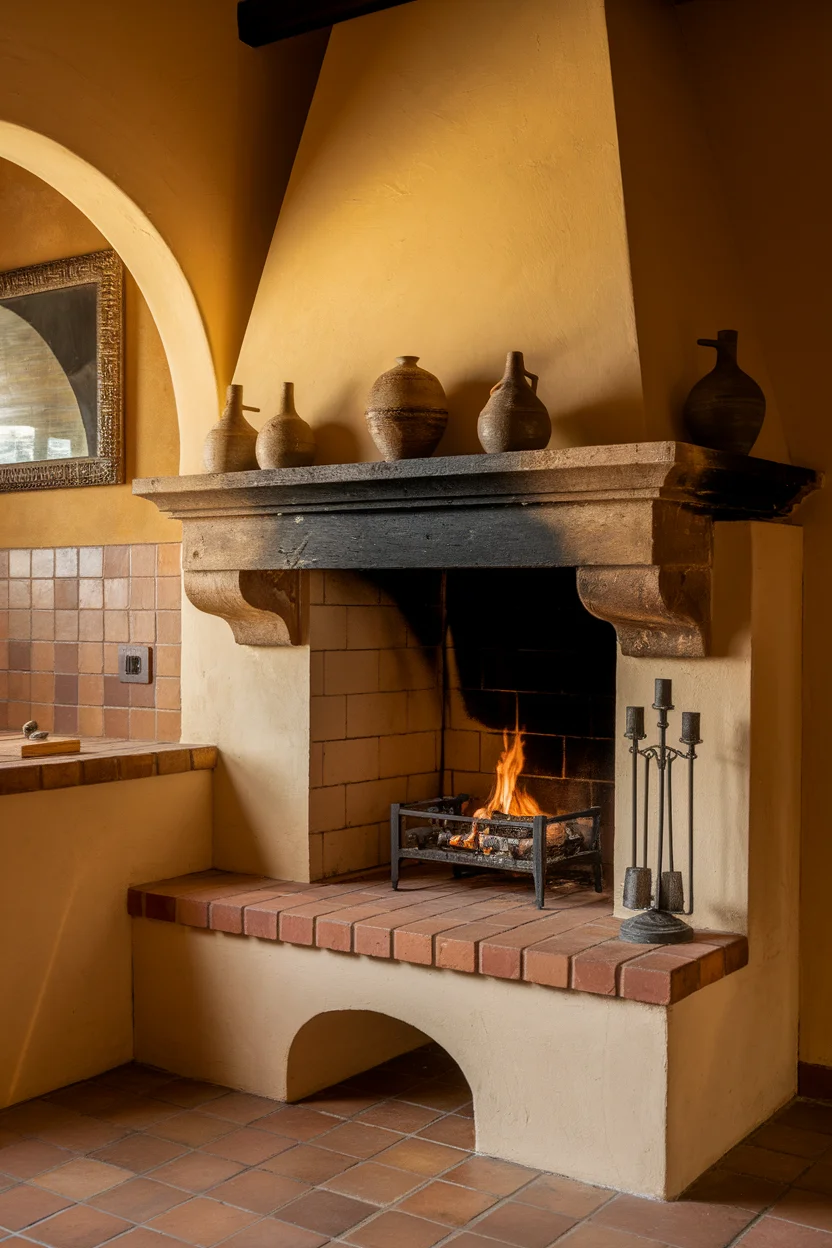The Spanish Mediterranean kitchen is a symphony of colors, flavors, and aromas that celebrates the rich culinary heritage of the Mediterranean coast. Rooted in the principles of freshness, simplicity, and bold flavors, this style of cooking draws inspiration from Spain???s diverse regions, blending the vibrant tastes of the land and sea. From the sun-kissed groves of olives and oranges to the bountiful harvests of tomatoes, peppers, and seafood, the Spanish Mediterranean kitchen is a testament to the harmonious blend of tradition and innovation. Whether you’re crafting a festive paella or enjoying the simplicity of tapas, these culinary ideas bring the warmth and vitality of Spain into your home.
Incorporate Earthy, Rustic Elements
Embrace the essence of Spanish Mediterranean kitchens by incorporating earthy, rustic elements that evoke a sense of warmth and simplicity. This style draws inspiration from the traditional kitchens of coastal and rural Spain, where natural materials and handmade finishes take center stage.
How to Achieve it:
Materials
:
– Use terracotta tiles or stone flooring to bring a natural, warm foundation to the kitchen.
– Opt for wooden beams or exposed brick on walls to add texture and rustic charm.
– Select handcrafted wooden cabinets with an aged finish to enhance the authentic look.
Color Scheme
:
– Choose a warm palette with shades of terracotta, ochre, and soft beige for a cozy atmosphere.
– Incorporate deep blues or olive greens as accents to mimic the Mediterranean landscape.
Decorative Elements
:
– Display open shelves with authentic Spanish pottery and ceramics.
– Hang wrought iron light fixtures to introduce a touch of old-world elegance.
– Include potted herbs or hanging garlic and chili clusters to add both decor and functionality.
Furniture and Textiles
:
– Integrate a rustic wooden dining table with mismatched, traditional chairs.
– Use linen or cotton fabrics with simple, earthy patterns for curtains and table covers.
Accessories
:
– Adorn countertops with olive wood cutting boards and baskets of fresh local produce.
– Implement copper or brass kitchenware as functional, decorative pieces.
By combining these elements, you can create a kitchen that authentically reflects the relaxed, inviting spirit of the Spanish Mediterranean style.
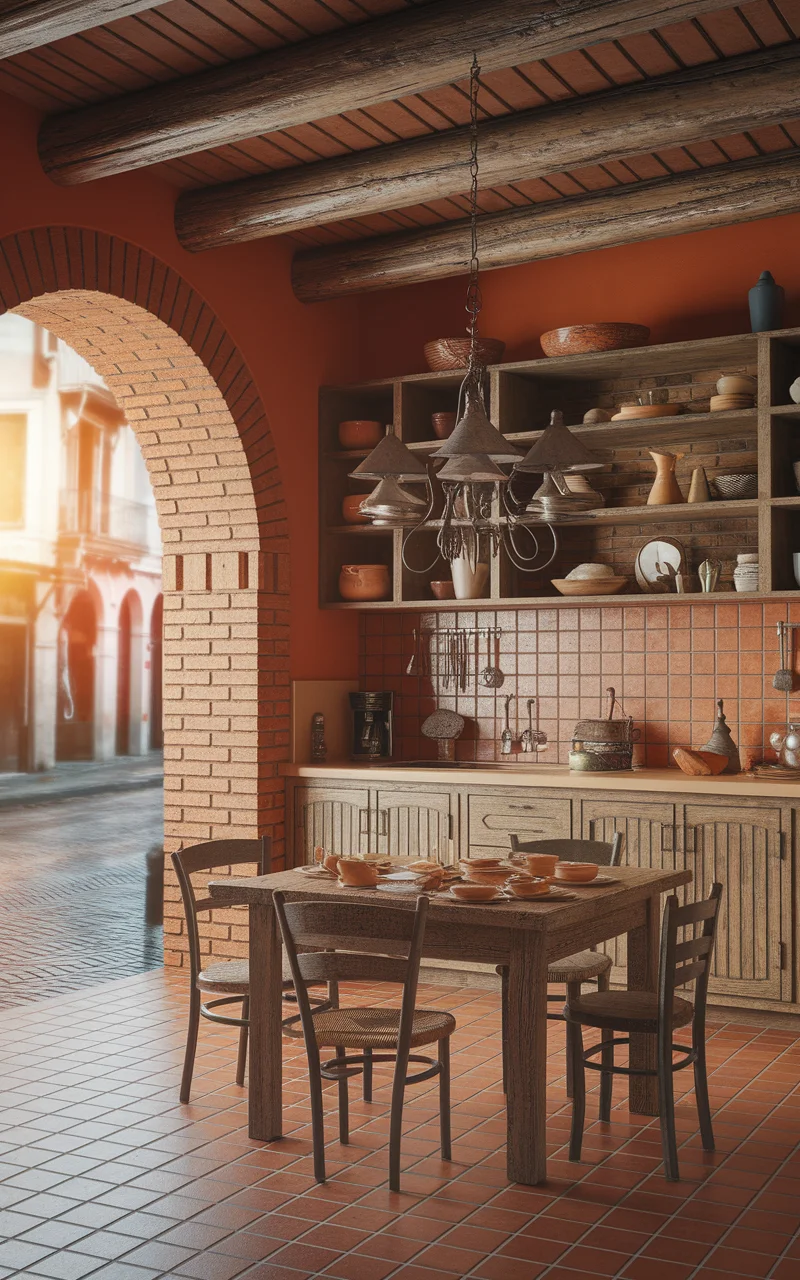
Infuse Vibrant, Sunlit Colors
Spanish Mediterranean kitchens are renowned for their vibrant, sun-drenched hues that capture the essence of the region’s sunny climate and rich culture. Infusing your kitchen with bright and cheerful colors can immediately transform it into a lively and welcoming space, reminiscent of a sunlit Spanish coastal home.
How to Achieve it:
Color Palette
:
– Start with a base of warm whites or soft creams to keep the kitchen feeling open and airy.
– Add pops of bold colors like vibrant yellows, deep reds, and rich oranges to evoke warmth and energy.
– Use cool blues and turquoise accents to reflect the Mediterranean Sea.
Wall Treatments
:
– Consider a colorful backsplash made from hand-painted Spanish tiles featuring intricate designs.
– Use wall stencils or decals with Mediterranean motifs to add artistic flair.
Cabinetry and Furniture
:
– Paint lower cabinets in a bold, lively color such as cobalt blue or sun-kissed yellow to draw the eye.
– Opt for open, colorful shelving to display vibrant cookware and dishware.
– Include a brightly painted kitchen island as a focal point.
Textiles
:
– Incorporate patterned textiles with vivid colors for curtains, cushions, and tablecloths.
– Use striped or floral motifs that capture the rustic charm and joy of Mediterranean living.
Decorative Elements
:
– Hang colorful artwork or prints that reflect Spanish scenery or still-life depictions.
– Use colorful, ceramic dishware and pottery for both functional purposes and decoration.
– Place fresh, seasonal flowers in vibrant vases to bring a natural dose of color and life into the space.
By carefully curating these vibrant color elements, you can emulate the lively spirit of Spanish Mediterranean kitchens, making your kitchen a warm, joyful, and inviting heart of the home.
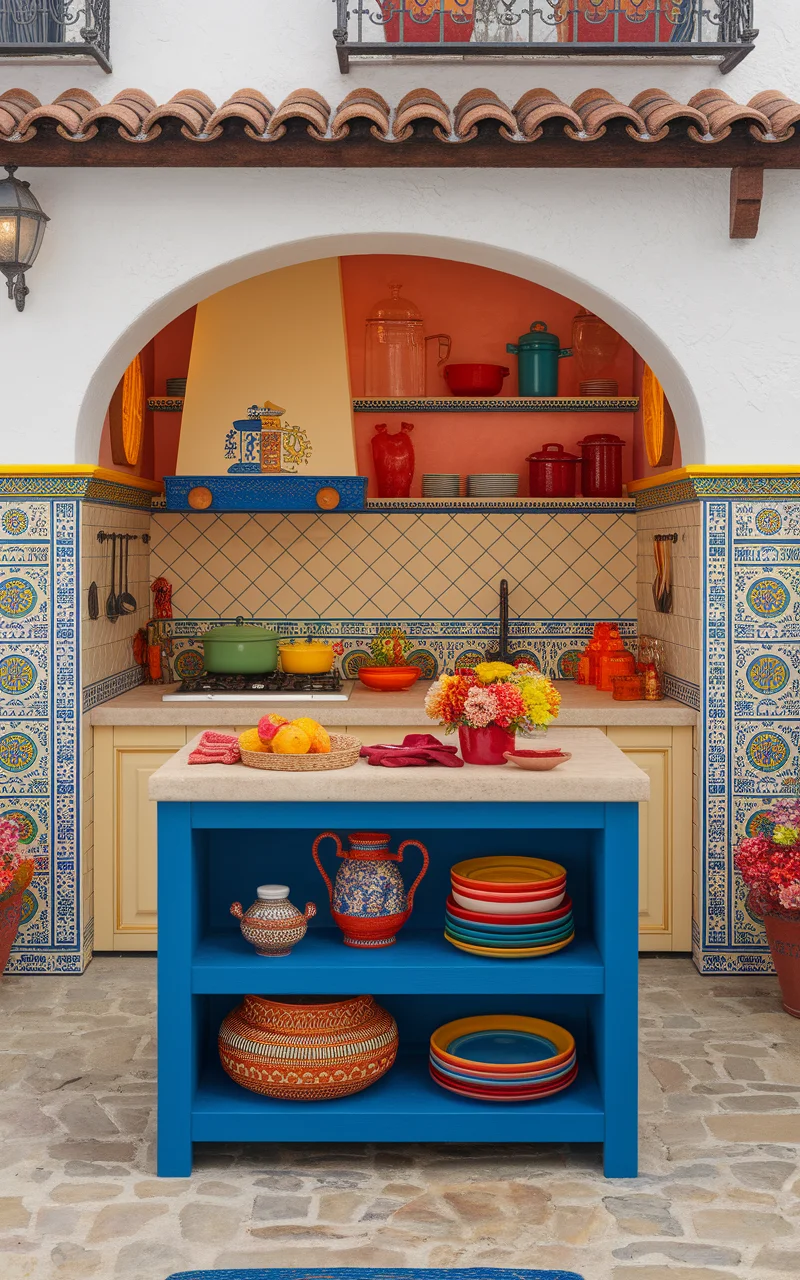
Embrace Traditional Spanish Tiles
Infuse your kitchen with the timeless elegance and artisanal charm of traditional Spanish tiles, a hallmark of Spanish Mediterranean design. The intricate patterns and vibrant colors of these tiles bring a piece of Spain’s rich cultural tapestry into the heart of your home. Whether used as a backsplash, flooring, or decorative accent, Spanish tiles add a stunning visual impact, creating a warm and inviting atmosphere.
How to Achieve it:
Choosing the Right Tile
:
– Select hand-painted ceramic tiles with classic Spanish motifs like arabesques, floral designs, and geometric patterns.
– Opt for tiles in earthy colors such as terracotta, cobalt blue, mustard yellow, and olive green, reminiscent of the Spanish palette.
Installation Areas
:
– Use tiles as a kitchen backsplash to create a focal point with artistic flair.
– Consider tiling the floor to create continuity and a cohesive look throughout the kitchen.
– Apply tiles to the front of an island or countertop edges for a decorative touch.
Incorporating Patterns and Designs
:
– Mix and match different tile patterns to create an eclectic, personalized look.
– Align tiles in a classic, symmetrical fashion for a traditional Spanish feel, or offset them for a more modern twist.
Complementary Elements
:
– Pair tiled surfaces with wrought iron fixtures or rustic wooden accents for contrast.
– Incorporate simple, neutral-colored cabinets to balance the vibrant tile designs.
Maintenance and Care
:
– Seal ceramic tiles to protect against stains and enhance their longevity.
– Regularly clean with gentle, non-abrasive cleaners to maintain the tiles’ beauty.
By integrating traditional Spanish tiles into your kitchen design, you create a space that celebrates the rich history and artistry of Spanish Mediterranean style, enveloping your culinary haven in warmth and character.
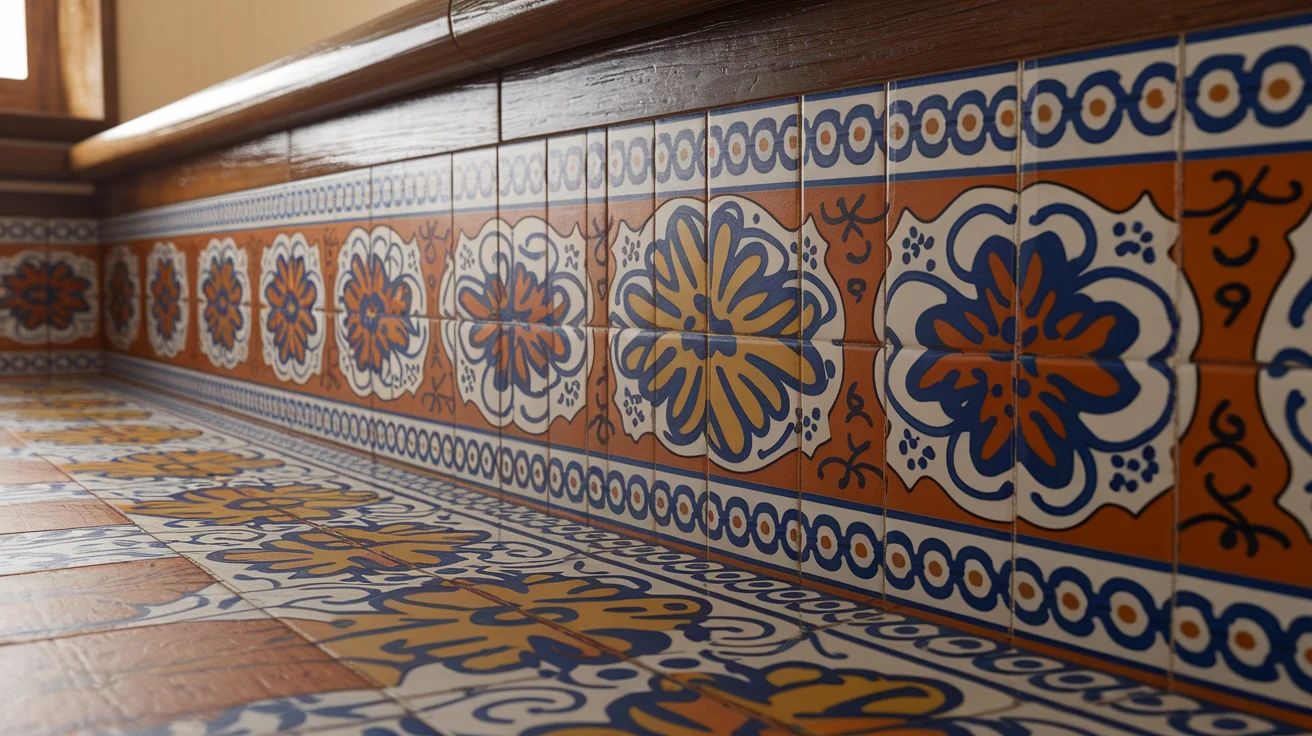
Create an Indoor-Outdoor Connection
Capture the essence of the Spanish Mediterranean lifestyle by establishing a seamless connection between your kitchen and the outdoors. Spanish homes often celebrate the beauty of the Mediterranean climate by bringing the outside in, allowing for a harmonious flow of light and air that enhances both the visual appeal and functionality of the space.
How to Achieve it:
Layout and Design
:
– Incorporate large, folding glass doors or sliding panels to create an open, airy transition between the kitchen and an outdoor patio or garden.
– Use open-plan kitchen layouts that naturally extend towards outdoor dining areas or courtyards.
Natural Light
:
– Install expansive windows or skylights to maximize natural light, creating a bright and inviting kitchen environment.
– Use sheer or lightweight curtains that allow sunlight to filter through without obstructions.
Outdoor Dining
:
– Set up a rustic dining area on the patio, complete with a wooden table and traditional woven chairs for al fresco meals.
– Integrate elements like a pergola or awning for shade, allowing for comfortable outdoor dining throughout the day.
Garden Integration
:
– Incorporate a small herb garden or planters with Mediterranean herbs like rosemary, thyme, and basil near the kitchen for easy access and visual continuity.
– Use terra cotta pots and Mediterranean plants to create a cohesive outdoor ambiance that mirrors the kitchen’s design.
Decorative Elements
:
– Employ textiles and cushions with patterns that complement indoor decor, carried outdoors to unify the space.
– Utilize decorative lanterns or fairy lights to add a charming glow to both indoor and outdoor areas during evenings.
By creating an indoor-outdoor connection, you encapsulate the relaxed and communal essence of Spanish Mediterranean living, turning your kitchen into a vibrant and harmonious extension of the natural surroundings.

Integrate Arched Architectural Features
Incorporate the classic elegance and architectural heritage of Spanish Mediterranean design by integrating arched features into your kitchen. Arches are a distinctive element of this style, reflecting a sense of grandeur and tradition while providing a soft, inviting ambiance. Whether through doorways, cabinetry, or even open shelving, arches add a fluid, organic dimension to your kitchen space, reminiscent of historic Spanish villas.
How to Achieve it:
Architectural Design
:
– Install arched doorways or entryways to create a visual transition between the kitchen and adjoining rooms.
– Incorporate archways into open shelving to soften the overall look and add depth.
Cabinet and Shelving Design
:
– Select cabinetry with arched paneling or incorporate arched glass cabinet doors for a classic touch.
– Design kitchen niches or alcoves with arched features to display decorative or functional items like wine bottles or cookbooks.
Decorative Elements
:
– Utilize arched window frames or mirrors to complement existing architectural features and add a reflective quality.
– Hang arched wrought iron or wooden wall decorations to create continuity in the design theme.
Color Scheme
:
– Use soft, earthy tones such as sandstone, cream, or light taupe to enhance the arch details subtly and maintain the serene atmosphere.
– Add muted blues or greens in small accents to complement the Spanish Mediterranean aesthetic without overpowering the arches.
Complementary Features
:
– Pair arches with rustic beams or carved wooden elements for added texture and warmth.
– Incorporate gentle lighting, such as pendant lights or chandeliers, to highlight archways and create visual interest.
By integrating arched features into your kitchen design, you capture the essence of Spanish Mediterranean style, offering a harmonious blend of architectural beauty and functional space that is both timeless and inviting.
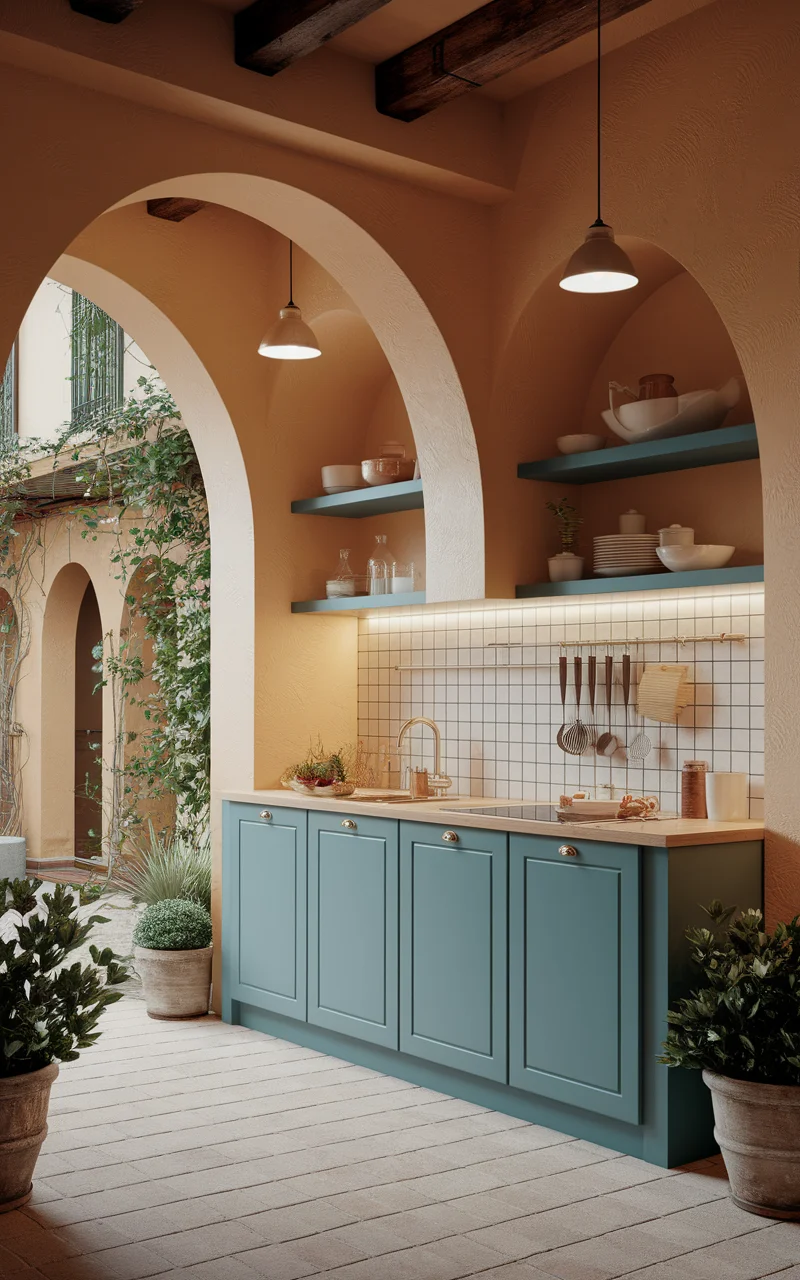
Introduce Spanish-Inspired Textured Walls
Bring the rich textures and rustic charm of Spanish Mediterranean style into your kitchen by introducing Spanish-inspired textured walls. This design approach captures the essence of old-world Spain, where walls tell a story through their tactile finishes. The textures, whether achieved through plaster, stucco, or lime wash, add depth and warmth, evoking the timeless allure of coastal and rural Spanish homes.
How to Achieve it:
Wall Treatment Techniques
:
– Apply a lime wash finish to walls for a smooth, chalky texture that absorbs light beautifully while allowing the structure beneath to breathe.
– Use traditional plaster techniques, including tadelakt or venetian plaster, to create depth and a slightly glossy surface.
– Consider rough stucco or faux finish treatments that mimic the uneven, rustic textures found in historic Spanish architecture.
Color Scheme
:
– Select warm, earthy tones such as rich terracotta, sun-bleached ochre, or soft, sandy beige to create a cozy, inviting atmosphere.
– Add subtle highlights with creamy whites or pale greys to keep the texture focal while maintaining a light, airy feel.
Complementary Elements
:
– Pair textured walls with simple, natural wooden accents to enhance the rustic charm of the kitchen.
– Install wrought iron or brass fixtures that stand out against the textured backdrop, adding to the Spanish aesthetic.
Decorative Elements
:
– Hang authentic Spanish artwork or decorative ceramics that complement the color and texture of the walls.
– Use wall sconces or pendant lighting to cast gentle shadows, highlighting the texture and adding dimension.
Maintenance and Care
:
– Seal textured surfaces appropriately to protect against stains and scruffs while preserving the finish’s natural beauty.
– Dust and clean regularly with soft, non-abrasive cloths to maintain the texture over time.
By integrating textured walls into your kitchen, you create a rich, tactile experience that embodies the authenticity of Spanish Mediterranean design, making your kitchen an expressive and soulful space.
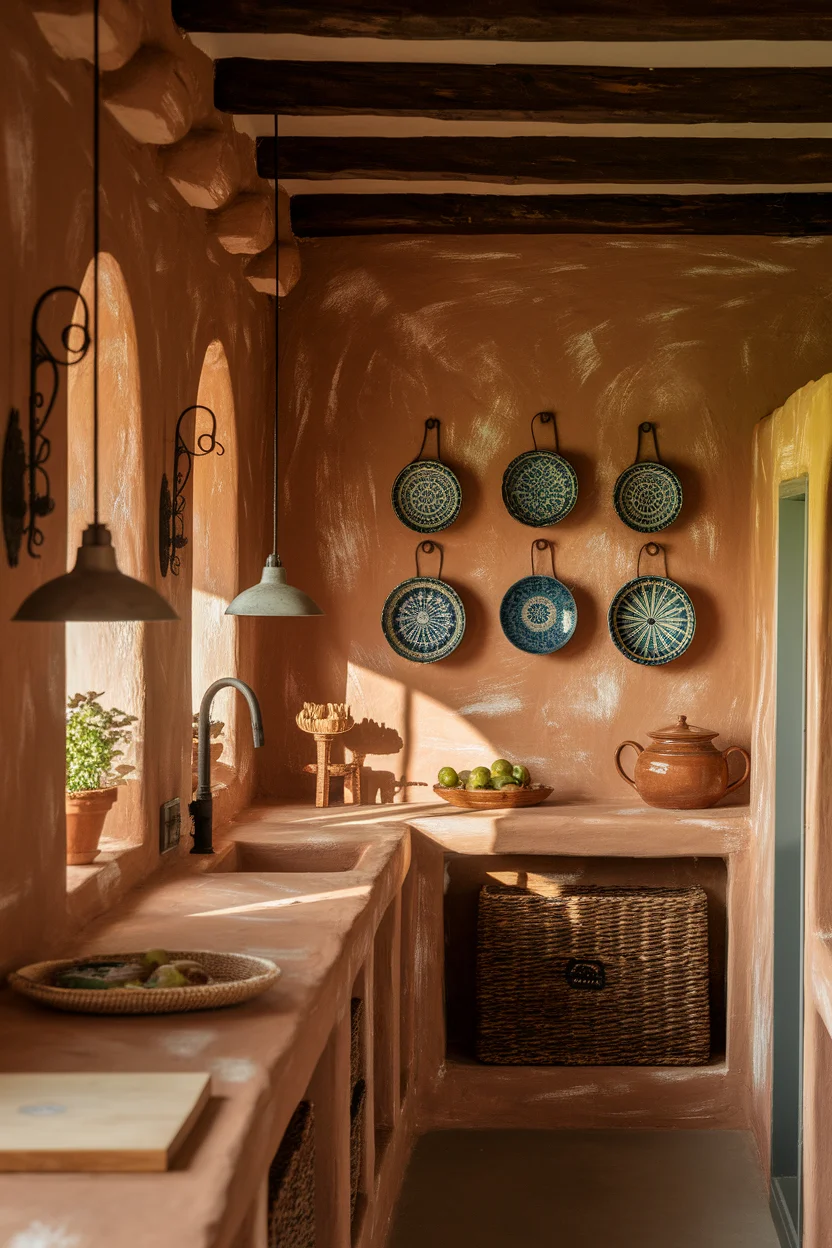
Utilize Handcrafted Wooden Features
Embrace the artisanal beauty of Spanish Mediterranean kitchen design by incorporating handcrafted wooden features into your space. This style celebrates craftsmanship, emphasizing the use of natural wood elements that instill warmth and authenticity. From ceiling beams to cabinetry, the incorporation of these bespoke details creates a timeless, rustic ambiance, echoing the traditional homes of Spain’s coastal and countryside areas.
How to Achieve it:
Wood Selection
:
– Choose reclaimed wood for its unique character and aged appearance, adding an element of history and sustainability.
– Opt for hardwoods like oak, walnut, or chestnut, which offer durability and a rich, natural finish.
Ceiling and Beams
:
– Install exposed wooden beams for a classic Spanish look, enhancing vertical visual interest and adding a sense of coziness.
– Consider a coffered ceiling with wooden panels for an elegant, traditional touch.
Cabinetry and Furniture
:
– Design kitchen cabinets using handcrafted wood with intricate carvings or detailed hardware to add depth and texture.
– Incorporate a rustic wooden kitchen island with fine craftsmanship and functional elements like built-in shelving or wine racks.
Color Scheme
:
– Maintain natural wood hues, pairing them with muted earthy tones such as taupe, olive, or dusty blues to complement the wooden accents.
– Use soft whites or creams on surrounding walls to create a light, airy contrast that highlights the wood features.
Complementary Elements
:
– Pair wooden features with natural stone countertops or a terracotta tile backsplash for a harmonious blend of textures.
– Utilize wrought iron or vintage brass fixtures to add elegance and continuity to the overall design.
Decorative Elements
:
– Accent with wooden breadboards, rolling pins, or artisanal bowls on open shelves for functional decor.
– Include handwoven baskets or wooden utensils to accentuate the rustic charm of the kitchen.
By weaving handcrafted wooden features into your kitchen design, you bring the enduring spirit of Spanish Mediterranean tradition into your home, creating a welcoming, soulful space that reflects the beauty of craftsmanship and the warmth of natural materials.
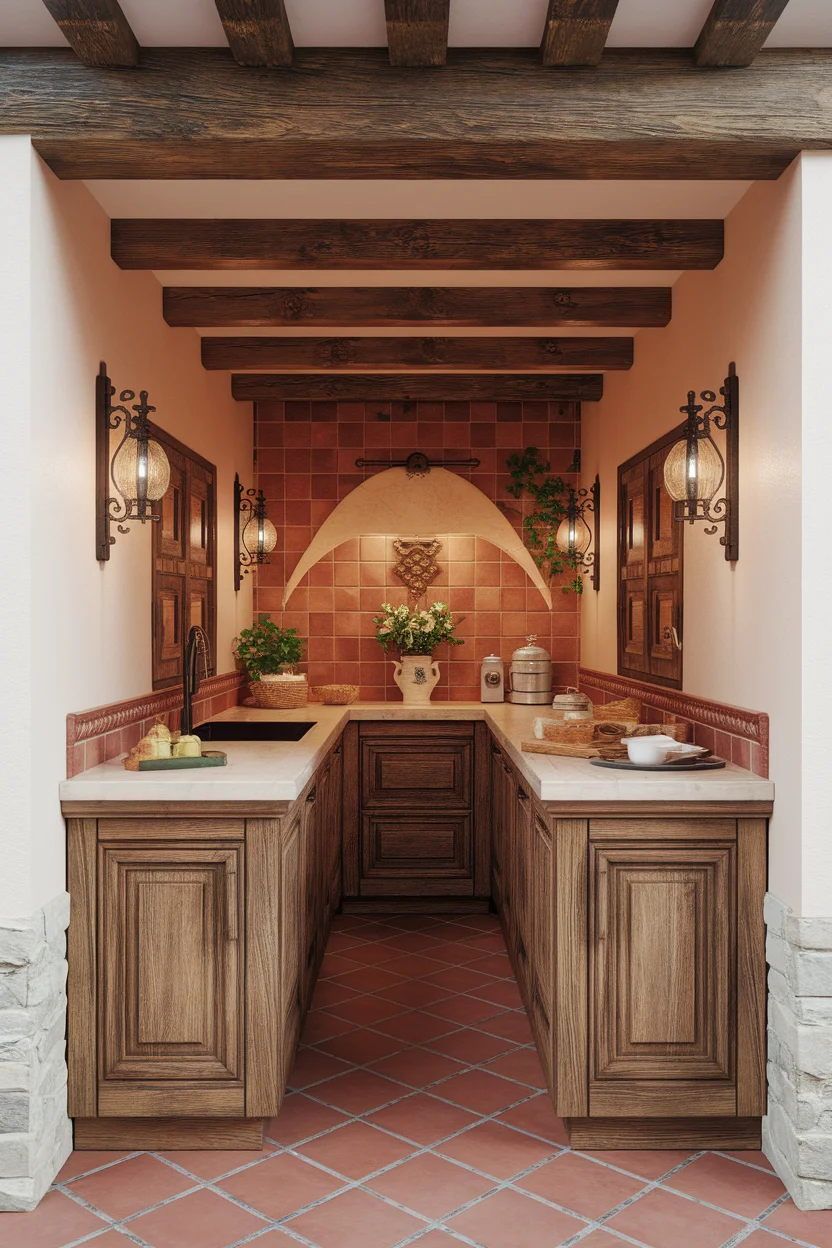
Feature Ornate Spanish Ironwork
Introduce the timeless elegance of Spanish Mediterranean design into your kitchen by featuring ornate ironwork. This design element is deeply rooted in Spain’s architectural heritage and adds a striking, yet classic touch that perfectly complements Mediterranean aesthetics. From intricate light fixtures to decorative railings and cabinet hardware, Spanish ironwork provides both beauty and function, lending a timeless, handcrafted charm to your kitchen space.
How to Achieve it:
Lighting
:
– Install wrought iron chandeliers or pendant lights with detailed scrollwork for an authentic old-world ambiance.
– Use wall sconces with stained glass accents to create a warm, inviting glow.
Doors and Windows
:
– Incorporate iron grilles or gates in kitchen doors and windows to evoke traditional Spanish design while providing security and durability.
– Opt for wrought iron window boxes or balcony railings visible from the kitchen to create continuity in design.
Cabinetry and Furniture
:
– Choose cabinets with decorative iron hardware, such as handles or knobs, to introduce subtle yet impactful detail.
– Integrate iron barstools or chairs with upholstered seats around a kitchen island for functional seating with character.
Color Scheme
:
– Pair ironwork with a neutral color palette featuring soft taupes, creams, and muted olives to keep the ironwork as the focal point.
– Add terra cotta reds or rustic oranges as accents to reflect the authentic warmth of the Mediterranean.
Decorative Elements
:
– Display ornate Spanish-style iron wall decor or artistic pieces to enhance the theme.
– Use iron pot racks or hanging pan holders for both a practical solution and decorative appeal.
By incorporating Spanish ironwork into your kitchen, you can capture the classic beauty and craftsmanship characteristic of the Spanish Mediterranean style, transforming your cooking space into an enchanting blend of traditional elegance and modern function.
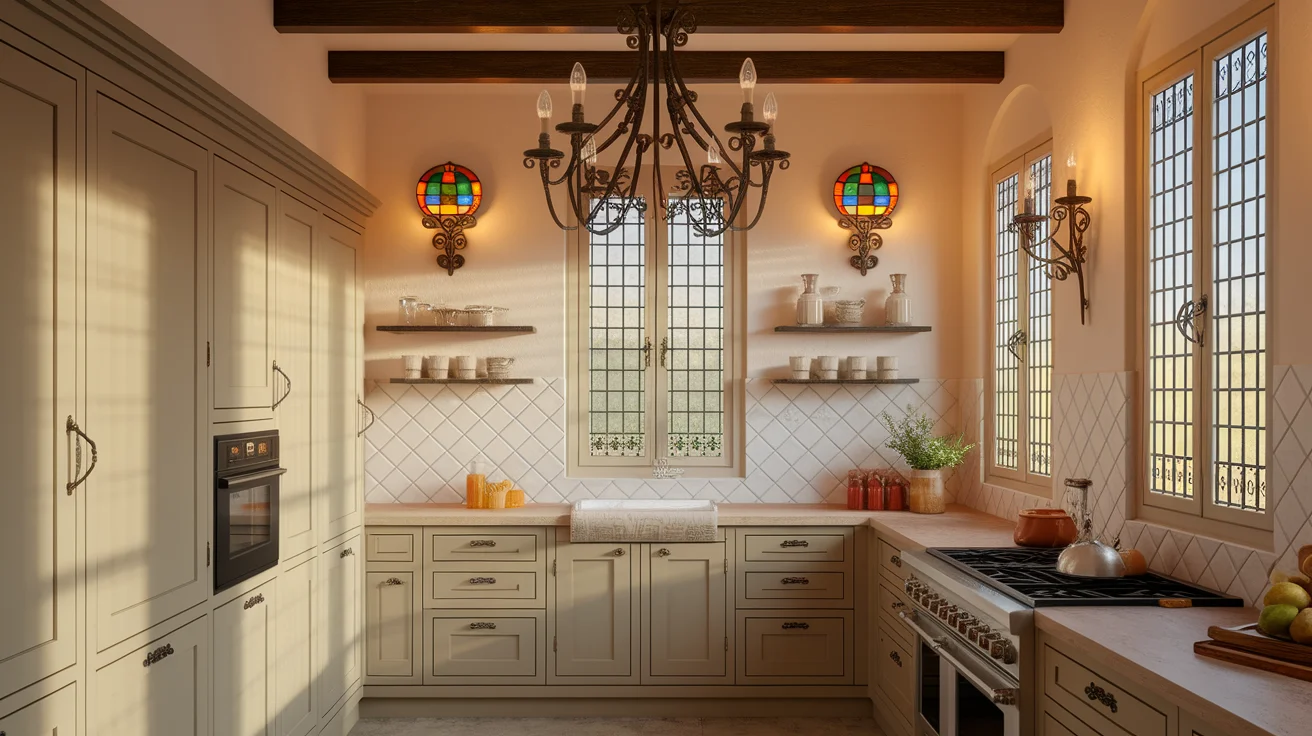
Incorporate Vibrant Spanish Tiles for Artistic Backsplashes
Introduce the allure and artistry of Spanish Mediterranean style into your kitchen by incorporating vibrant Spanish tiles as backsplashes. These tiles are notable for their intricate patterns, vivid colors, and skilled craftsmanship, offering a captivating way to infuse character and cultural richness into your kitchen space. By choosing artistic designs that range from bold geometrics to delicate florals, you can transform your backsplash into a memorable feature that stands out while still harmonizing with the surrounding elements.
How to Achieve it:
Tile Selection
:
– Choose hand-painted ceramic or encaustic tiles featuring traditional Spanish designs, such as floral motifs, medallions, or arabesques.
– Opt for tiles with a high-gloss finish to enhance color vibrancy and create a reflective quality.
Color Scheme
:
– Select a palette that includes vibrant blues, deep reds, sunny yellows, and earthy greens reminiscent of Spanish landscapes.
– Use neutral tones on walls and cabinetry, like soft whites or taupes, to let the backsplash color pop.
Installation and Design
:
– Plan the layout with a mix of tile sizes and orientations to add visual interest and a personalized touch.
– Consider framing your backsplash with a contrasting border tile to define the space and create a striking visual boundary.
Complementary Elements
:
– Pair the colorful backsplash with understated countertops, such as natural stone or polished concrete, for balance.
– Choose simple, handcrafted wooden cabinetry or open shelves to showcase and complement the tile design.
Decorative Touches
:
– Display complementary Spanish ceramic dishware or pottery on nearby open shelves for a cohesive look.
– Use matching or coordinated tiles in other areas, like accent walls or island fronts, for continuity throughout the kitchen.
Maintenance and Care
:
– Ensure tiles are sealed properly after installation to protect against moisture and staining.
– Clean regularly with non-abrasive products to preserve the tiles’ vibrant colors and intricate designs.
By incorporating vibrant Spanish tiles as backsplashes, you can create a colorful focal point that celebrates the artistic heritage of the Spanish Mediterranean, adding a lively and engaging element to your kitchen decor.
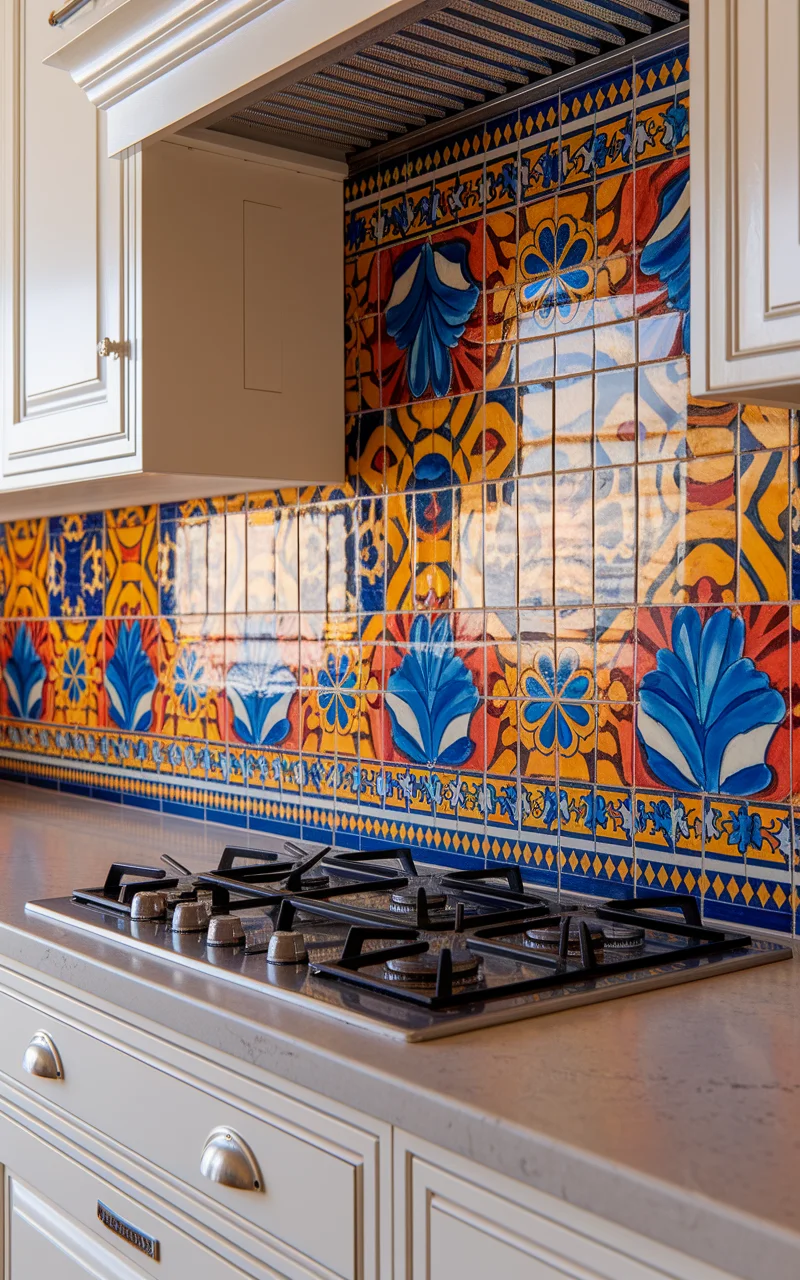
Introduce a Cozy Fireplace Element
Infuse the warm, inviting essence of a Spanish Mediterranean kitchen by incorporating a cozy fireplace element. This traditional feature not only serves as a functional cooking source in historical contexts but also adds a comforting ambiance to the space. A fireplace evokes the old-world charm of Spanish villas, where families gather for meals and conversation, creating a heartwarming focal point in your kitchen.
How to Achieve it:
Design and Placement
:
– Choose a corner or central wall in the kitchen to install the fireplace, considering space and aesthetic prominence.
– Opt for an open hearth design reminiscent of traditional Spanish homes, allowing for a pleasant view of the flames.
Materials
:
– Use natural stone or brick for the fireplace surround to blend with the rustic style of a Spanish Mediterranean kitchen.
– Consider a worn, patinated finish on the mantel to enhance the aged, historical appeal.
Color Scheme
:
– Select warm, earthy tones like terra cotta or burnt umber for the fireplace materials to blend with traditional Spanish colors.
– Use subtle, complementary accent colors like soft golds or muted greens to enrich the overall palette of your kitchen.
Decorative Elements
:
– Decorate the mantel with Spanish pottery, wrought iron candle holders, or a collection of vintage family photos to add personality.
– Hang a rustic, ornate mirror or a piece of Spanish-inspired art above the fireplace to draw the eye upwards and create visual interest.
Functional Elements
:
– Utilize the hearth as a practical cooking space for open-flame grilling or slow-cooked dishes to enhance the culinary experience.
– Store firewood in a charming, woven basket or wrought iron holder to keep it accessible and aesthetically pleasing.
Ambiance Considerations
:
– Install ambient lighting around the fireplace area, such as wall sconces or mood lighting, to highlight its presence during evening gatherings.
– Incorporate comfortable seating nearby, like cushioned benches or chairs, for family and guests to relax and enjoy the warmth.
By introducing a cozy fireplace element to your kitchen, you embrace the heartwarming and communal spirit of Spanish Mediterranean living, creating a space where stories are shared and memories are made around the comforting glow of a fire.
